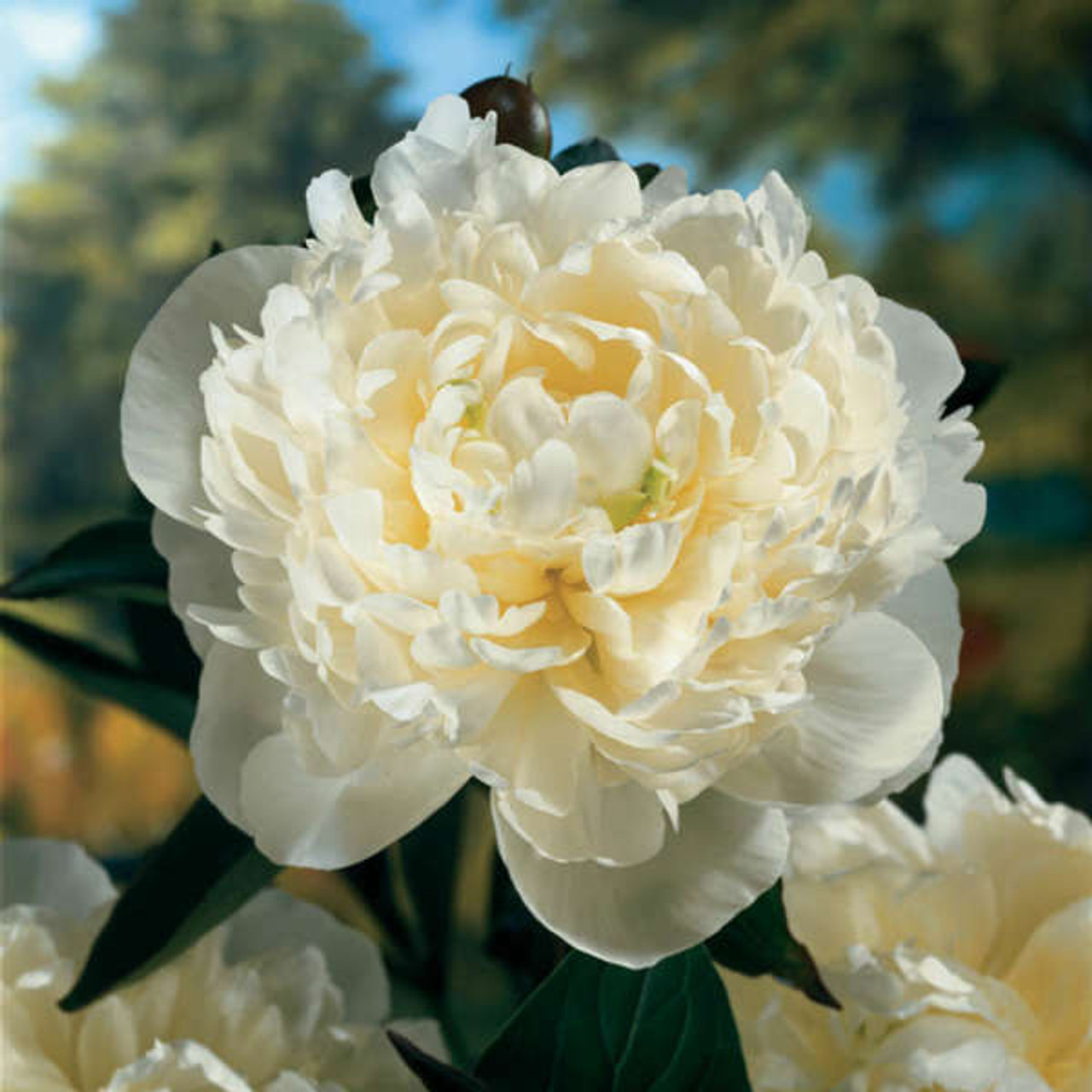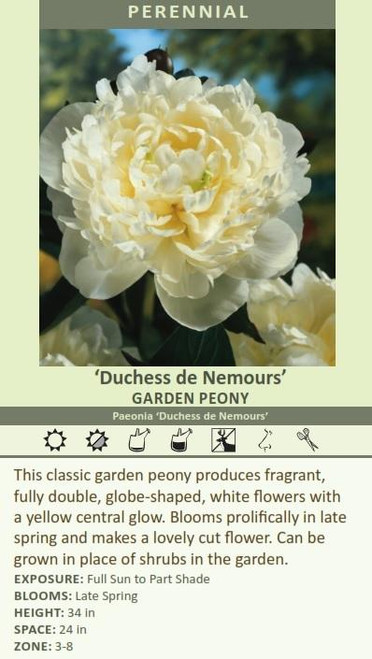Product Description
Paeonia 'Duchesse de Nemours' (10) Plants
- Flower type: Double.
Zones: 3 to 8
Full sun to part shade.
Bloom time: Mid season, Late Spring
Height: 34 Inches Spread: 24 Inches - Deer and Rabbit Resistant
Fragrant, milky white, globe-shaped blossoms with green carpels and a yellow center glow are produced profusely in late spring. This double variety has particularly attractive foliage and strong stems. Well-branched and vigorous, 'Duchesse de Nemours' is a powerhouse of color, scent, and form. It received the prestigious Award of Garden Merit from the Royal Horticulture Society in 1993.
Paeonia 'Duchesse de Nemours' is a classic and timeless herbaceous peony that has been a favorite among gardeners for over 150 years. It is renowned for its elegant white flowers, strong fragrance, and reliable performance. Here is a closer look at this beloved peony cultivar:
Appearance:
- Milky White Flowers: 'Duchesse de Nemours' produces large, double, globe-shaped flowers in a beautiful milky white color. The center of the flower has a subtle yellow glow, adding a touch of warmth. The flowers are about 5 inches wide and have a strong, sweet fragrance.
- Sturdy Stems: The flowers are held on strong, upright stems that do not require staking, even when the blooms are fully open.
- Attractive Foliage: The foliage is a deep green color and provides an attractive backdrop for the flowers. It remains healthy and lush throughout the growing season.
Growing Conditions:
- Sunlight: Thrives in full sun to partial shade. It prefers full sun but can tolerate some shade, especially in hot summer climates.
- Soil: Prefers well-drained, fertile soil.
- Hardiness Zones: Suitable for USDA hardiness zones 3-8, making it a versatile choice for a wide range of climates.
Care:
- Low Maintenance: 'Duchesse de Nemours' is a relatively low-maintenance plant.
- Watering: Water regularly, especially during dry periods, but avoid overwatering.
- Fertilizing: Fertilize in early spring with a balanced fertilizer or compost to promote healthy growth and flowering.
- Deadheading: Deadheading spent flowers can help prolong the bloom time and keep the plant looking tidy.
Uses:
- Borders: Adds a classic touch of elegance and fragrance to borders and beds.
- Specimen Plant: Its impressive flowers and attractive foliage make it an excellent specimen plant.
- Cut Flowers: The long-lasting flowers are prized for use in cut flower arrangements, especially bridal bouquets.
Additional Information:
- Long Bloom Time: 'Duchesse de Nemours' has a relatively long bloom time for a peony, typically flowering for about 2 weeks in late spring to early summer.
- Disease Resistance: It is generally disease-free and resistant to common peony problems like botrytis blight.
- Deer and Rabbit Resistant: Deer and rabbits tend to avoid peonies.
- Attracts Pollinators: The flowers attract butterflies and other pollinators.
If you are looking for a classic and elegant peony with beautiful white flowers, a strong fragrance, and a long bloom time, Paeonia 'Duchesse de Nemours' is an excellent choice. It is a reliable and beloved addition to any garden.
Other Details
The most important part of the plant is its root system. Healthy roots are the foundation of a healthy, vibrant plant. The type of plug container used is based on the specific needs of the plants. Perennials offered as bare root traditionally perform better when planted as bare root.Planted in a specialized mix, potted plants have well established root systems. Top growth stage will vary depending on the current life cycle and time of year when shipped. In Winter and early Spring dormant plants may be shipped. Dormant plants may be planted right away, even before the last frost date.
Most bare root varieties are field grown for at least one season, though Hemerocallis and Hosta are grown for two seasons. The bulk of the soil is removed during the harvesting process and the tops of most varieties are trimmed back to the crown. They are graded, packed in shredded aspen or sphagnum moss and stored in freezers until ready to be shipped.
See our Container Sizes and Bare Root Perennials pages for more information.
Plant information and care is provided in the Overview section, Plant Genus Page and general information is provided in the Planting Care & Guides. Additional questions can be asked on each Plant page.
Plant Spacing: Using the maximum mature spread or width of a plant to guide spacing, ensures space to grow to full size. To fill an area sooner, plant them closer together. Just remember, future thinning or transplanting may be needed.
Water: Keep a close eye on newly planted perennials, especially throughout the first growing year. Most early plant loss is due to too much or too little water!








